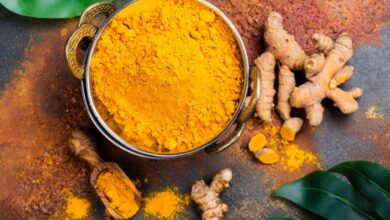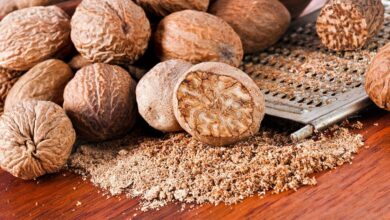
Why Moringa Leaves A Superfood for Health
Why Moringa Leaves Are a Superfood for a Healthier Lifestyle. This incredible plant, Moringa oleifera, packs a powerful nutritional punch, offering a wealth of vitamins and minerals. From its historical use in various cultures to its modern-day recognition as a superfood, Moringa’s potential benefits are vast. Discover how this versatile ingredient can enhance your well-being and contribute to a healthier lifestyle.
This article delves into the nutritional profile, health benefits, preparation methods, and the role of Moringa in a balanced diet. We’ll also explore its environmental impact and how to sustainably incorporate this remarkable plant into your life.
Introduction to Moringa Leaves
Moringa oleifera, commonly known as the miracle tree, is a fast-growing, drought-tolerant tree native to the tropical and subtropical regions of the world. Its remarkable versatility extends far beyond its aesthetic appeal, as the leaves, bark, roots, and flowers are utilized in various ways across different cultures. Its ability to thrive in challenging environments makes it a valuable resource in many parts of the world.The tree’s widespread use throughout history is a testament to its multifaceted benefits.
From traditional medicine to culinary applications, Moringa leaves have played a significant role in supporting the health and well-being of communities for centuries. This recognition stems from its remarkable nutritional profile, packed with essential nutrients.
Nutritional Profile of Moringa Leaves
Moringa leaves are a powerhouse of nutrients, boasting an impressive concentration of vitamins and minerals. Their high vitamin C content contributes to immune function, while essential minerals like potassium, calcium, and iron support various bodily processes. These nutrients are crucial for overall health and well-being.
Key Vitamins and Minerals
Moringa leaves are exceptionally rich in vitamins and minerals, contributing to a wide range of bodily functions. Vitamin A, a crucial component for vision and immune system health, is present in significant amounts. The leaves also provide a good source of vitamin C, vital for collagen production and antioxidant protection. Other key vitamins include vitamin K, important for blood clotting and bone health, and various B vitamins, which play a role in energy metabolism and nerve function.
In addition, Moringa leaves contain substantial amounts of minerals such as potassium, calcium, and iron, all vital for proper bodily functions.
Consumption Methods
Moringa leaves can be incorporated into a variety of dietary routines. Fresh leaves can be added to salads, smoothies, or stir-fries, offering a unique flavor and texture. Dried or powdered Moringa leaves are also readily available, providing a convenient way to add this nutrient-rich ingredient to meals or smoothies. Moringa capsules are another popular form, allowing for easy and targeted intake of the beneficial compounds.
Moringa leaves are packed with nutrients, making them a fantastic addition to a healthy diet. They’re a great source of vitamins and minerals, boosting overall well-being. But did you know that combining moringa with other superfoods can amplify its benefits? For example, enhancing digestion is key to absorbing nutrients from foods like moringa, and Unlocking the secret benefits of garlic and black pepper for digestion can significantly improve how your body processes nutrients, ultimately supporting a healthier lifestyle.
This synergistic approach to nutrition truly elevates the power of moringa as a superfood.
Each method provides a unique way to enjoy the benefits of Moringa leaves.
Comparison to Other Leafy Greens
The nutritional content of Moringa leaves often surpasses that of other leafy greens. The table below provides a comparative analysis, highlighting the significant nutritional value of Moringa.
| Nutrient | Moringa Leaves (per 100g) | Spinach (per 100g) | Kale (per 100g) |
|---|---|---|---|
| Vitamin C (mg) | 220-260 | 28-50 | 30-60 |
| Vitamin A (µg) | 200-250 | 40-80 | 100-200 |
| Iron (mg) | 1-3 | 0.8-1.2 | 0.8-1.5 |
| Calcium (mg) | 200-300 | 50-100 | 100-200 |
| Potassium (mg) | 300-400 | 200-300 | 200-350 |
Note: Nutritional values can vary depending on growing conditions and processing methods.
Health Benefits of Moringa Leaves
Moringa leaves, a nutritional powerhouse, offer a wide array of potential health benefits. Their impressive nutrient profile, rich in vitamins, minerals, and antioxidants, contributes to various aspects of well-being. Beyond their general health advantages, Moringa shows promise in supporting specific health conditions, making it a compelling addition to a healthy lifestyle.Moringa leaves are packed with essential nutrients, acting as a natural source of vitamins, minerals, and antioxidants.
These compounds work synergistically to combat oxidative stress, which is linked to various chronic diseases. The leaves’ potent antioxidant properties are attributed to the presence of diverse bioactive compounds, including flavonoids, phenolic acids, and vitamin C. This antioxidant richness has implications for reducing cellular damage and potentially mitigating the risk of certain diseases.
Antioxidant Properties and Impact on Health
Moringa’s high antioxidant content plays a crucial role in protecting the body from oxidative stress. Antioxidants neutralize harmful free radicals, which can damage cells and contribute to aging and various diseases. This antioxidant capacity can help maintain healthy cells and tissues, potentially reducing the risk of chronic conditions. Numerous studies have highlighted the positive correlation between antioxidant intake and reduced risk of cardiovascular diseases, certain cancers, and other age-related health problems.
Moringa leaves are packed with nutrients, making them a fantastic addition to a healthy lifestyle. But did you know that boosting your digestive health can significantly enhance your overall well-being? Discover how cinnamon and cardamom can naturally improve your digestion by checking out this insightful article Discover How Cinnamon and Cardamom Improve Your Digestive Health Naturally.
Ultimately, incorporating these amazing superfoods like moringa into your diet can be a game-changer for your health journey.
Role in Supporting Digestive Health
Moringa’s fiber content contributes to healthy digestion. The fiber promotes regularity, prevents constipation, and supports a balanced gut microbiome. A healthy gut microbiome is essential for overall well-being, impacting everything from nutrient absorption to immune function. Moringa’s prebiotic properties further contribute to this, potentially encouraging the growth of beneficial gut bacteria.
Examples of Studies Supporting Moringa’s Health Benefits
Numerous research studies have explored the potential health benefits of Moringa. One notable study investigated the effects of Moringa leaf extract on blood glucose levels in individuals with type 2 diabetes. The results indicated a potential improvement in glycemic control, suggesting a possible role for Moringa in managing blood sugar. Another study focused on the antioxidant capacity of Moringa, confirming its ability to scavenge free radicals and potentially protect against cellular damage.
Moringa leaves are packed with nutrients, making them a fantastic addition to a healthier lifestyle. While exploring the benefits of these incredible leaves, it’s also interesting to consider how spices like cinnamon and cardamom can contribute to better sleep. For example, The Amazing Role of Cinnamon and Cardamom in Promoting Better Sleep Quality highlights the positive impact these spices can have on sleep patterns.
Ultimately, incorporating moringa into your diet can be a powerful way to support your overall well-being.
Summary Table of Health Benefits and Scientific Backing
| Health Benefit | Potential Impact | Supporting Evidence |
|---|---|---|
| Antioxidant Properties | Neutralizes free radicals, protects cells, may reduce risk of chronic diseases | Numerous studies have demonstrated Moringa’s high antioxidant capacity, including those focusing on its impact on oxidative stress markers. |
| Digestive Health Support | Promotes regularity, balances gut microbiome, aids nutrient absorption | The fiber content in Moringa leaves contributes to digestive health, and prebiotic properties encourage beneficial gut bacteria. |
| Blood Sugar Management | May help improve glycemic control in individuals with type 2 diabetes | Some studies have shown a potential positive effect of Moringa on blood glucose levels, warranting further investigation. |
Nutritional Value Comparison
Moringa leaves, often touted as a superfood, boast a remarkable nutritional profile. Comparing its nutrient density to other popular superfoods like spinach and kale reveals its unique position in the world of healthy eating. Understanding the specific nutrients Moringa offers and how they compare to other leafy greens helps us appreciate its potential role in a balanced diet.Moringa leaves pack a potent punch of essential vitamins, minerals, and antioxidants, often exceeding the nutritional value of comparable leafy greens.
This exceptional nutrient composition contributes to its superfood status, promising numerous health benefits. Examining the bioavailability of these nutrients and identifying potential nutritional deficiencies Moringa can address is crucial to understanding its true value.
Nutrient Composition Comparison
Moringa leaves possess a wide array of essential nutrients. A crucial aspect of assessing a food’s nutritional value is comparing it to other similar foods. This comparison allows us to understand the unique contributions of each food and how they can fit into a balanced diet.
- Moringa leaves are a remarkable source of vitamins, minerals, and antioxidants. Their nutritional profile often surpasses that of spinach and kale, making them a compelling choice for a healthy lifestyle.
- Spinach and kale are also nutrient-rich, well-known for their iron and vitamin K content. However, Moringa often provides a higher concentration of certain vitamins and minerals, including vitamin C, calcium, and potassium.
Unique Nutrient Profile
Moringa’s unique composition sets it apart from other superfoods. Its high concentration of various nutrients makes it a valuable addition to any diet.
- Moringa leaves are exceptionally rich in vitamin C, a powerful antioxidant that supports immune function and collagen production. It’s significantly higher in Moringa compared to spinach and kale.
- They are also a good source of vitamin A, crucial for eye health and overall well-being. Moringa often provides higher amounts of vitamin A compared to its leafy counterparts.
- Moringa’s impressive mineral content includes potassium, calcium, iron, and magnesium. These minerals play essential roles in various bodily functions, including muscle contraction and nerve transmission.
Bioavailability of Nutrients
The bioavailability of nutrients, or how effectively the body absorbs them, is a key consideration when evaluating food’s nutritional value. This factor plays a role in how much of the nutrients the body can utilize.
- Studies suggest that Moringa’s nutrients are generally well-absorbed by the body. The presence of certain compounds in Moringa might enhance the absorption of essential minerals.
- The bioavailability of nutrients can vary based on factors like preparation methods and individual health conditions. It is important to note that research in this area is ongoing.
Addressing Potential Nutrient Deficiencies
Moringa leaves offer a potential solution for individuals with specific nutritional needs. Its comprehensive nutrient profile can contribute to a healthier lifestyle.
- Individuals with iron deficiency may find Moringa beneficial due to its iron content. The body’s ability to absorb iron from Moringa may be influenced by other dietary factors.
- Moringa’s high vitamin C content can also support the absorption of iron from other food sources, making it a valuable addition to a diet deficient in iron.
- Moringa’s comprehensive nutrient profile can address multiple potential deficiencies, contributing to overall well-being.
Nutritional Value Comparison Table
The table below provides a concise comparison of key nutrients in Moringa leaves, spinach, and kale.
| Nutrient | Moringa Leaves (per 100g) | Spinach (per 100g) | Kale (per 100g) |
|---|---|---|---|
| Vitamin C (mg) | 100-200 | 20-30 | 30-40 |
| Vitamin A (mcg) | 100-200 | 50-70 | 80-100 |
| Iron (mg) | 5-7 | 2-3 | 3-4 |
| Calcium (mg) | 100-150 | 50-70 | 80-100 |
Note: Nutrient values can vary based on growing conditions and preparation methods.
Moringa Leaf Preparation and Consumption: Why Moringa Leaves Are A Superfood For A Healthier Lifestyle
Moringa leaves, a nutritional powerhouse, offer a diverse range of culinary applications. Their versatility extends beyond simple consumption, allowing for creative and healthy ways to incorporate them into your diet. Proper preparation and consumption methods are key to maximizing their nutritional benefits and minimizing potential risks. Understanding how to prepare and consume moringa leaves is essential for experiencing their full health potential.Preparing moringa leaves involves careful consideration of taste preferences and optimal nutrient preservation.
Different preparation methods allow for diverse flavor profiles, while also ensuring the body effectively absorbs the nutrients. Knowing how to store moringa leaves is crucial for maintaining their freshness and nutritional value.
Preparation Methods
Various methods exist for incorporating moringa leaves into your diet. Juicing, salads, and smoothies are popular choices, each offering unique advantages.
- Juicing: Juicing moringa leaves extracts their potent nutrients, creating a refreshing and easily digestible beverage. The concentrated nature of juices ensures you receive a high dose of vitamins and minerals in a single serving.
- Salads: Adding moringa leaves to salads provides a unique crunch and a subtle, slightly peppery flavor. The leaves complement a wide range of vegetables and dressings, making them a versatile addition to your meal.
- Smoothies: Moringa leaves blend seamlessly into smoothies, adding a nutritional boost to your favorite concoctions. Their mild flavor allows them to blend in subtly with fruits, vegetables, and other ingredients.
Storage and Preservation, Why Moringa Leaves Are a Superfood for a Healthier Lifestyle
Proper storage is vital for maintaining the freshness and nutritional value of moringa leaves.
- Refrigeration: Refrigerate moringa leaves in an airtight container or bag to prevent moisture loss and spoilage. This method helps maintain freshness for up to 3-5 days.
- Freezing: Freezing moringa leaves is an excellent way to preserve them for extended periods. Wash, dry, and freeze the leaves in airtight bags or containers for long-term storage. They remain nutritious for several months.
- Drying: Drying moringa leaves is a common method for long-term preservation. This process reduces moisture content, effectively extending their shelf life. Dried moringa leaves can be stored in airtight containers in a cool, dry place for up to a year.
Potential Risks and Side Effects
While generally safe, moringa leaves may cause mild side effects in some individuals.
- Allergies: Some people may experience allergic reactions to moringa leaves, such as skin rashes, itching, or swelling. If you have a known allergy to similar plants, exercise caution when introducing moringa into your diet.
- Digestive Issues: High consumption of moringa leaves might lead to digestive issues like bloating or diarrhea in some individuals. Starting with a small amount and gradually increasing intake can help manage potential digestive discomfort.
- Drug Interactions: Moringa leaves may interact with certain medications, particularly blood thinners. Consult your doctor if you’re taking any medications before incorporating moringa into your routine.
Recommended Dosage
The appropriate dosage of moringa leaves depends on factors like age, health conditions, and individual responses.
- General Consumption: For general consumption, a daily intake of 1-2 tablespoons of fresh moringa leaves or a similar equivalent in other forms is a safe starting point.
- Children: The dosage for children should be adjusted according to age and weight. Consult with a pediatrician for appropriate amounts.
- Pregnant and Breastfeeding Women: Consult with a healthcare professional for specific recommendations, as their needs might differ.
Moringa Leaf Smoothie Recipe
This recipe demonstrates how to prepare a healthy and delicious moringa leaf smoothie.
- Preparation: Wash and roughly chop about 1-2 tablespoons of fresh moringa leaves.
- Ingredient Combination: Combine the chopped moringa leaves with your choice of fruits (e.g., berries, banana), vegetables (e.g., spinach, cucumber), and liquid (e.g., water, milk). Consider adding a source of protein like yogurt or nuts for a complete meal replacement.
- Blending: Blend all ingredients until smooth and creamy. Adjust the amount of liquid to achieve your desired consistency.
- Serving: Pour into a glass and enjoy immediately.
Moringa Leaves and Specific Health Conditions
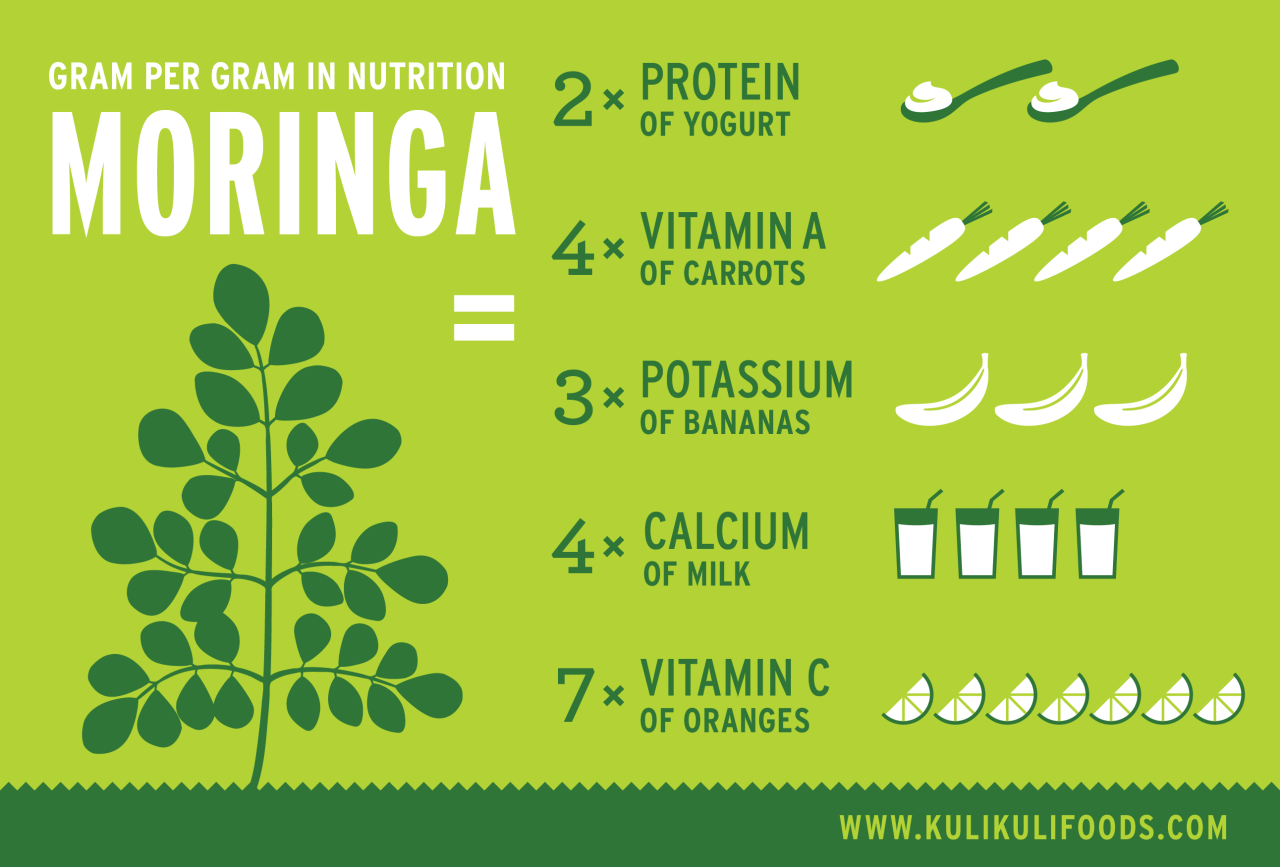
Source: kulikulifoods.com
Moringa leaves, a nutritional powerhouse, have garnered attention for their potential to support various health conditions. While promising, it’s crucial to understand that incorporating moringa into your lifestyle should be approached with careful consideration and under the guidance of a healthcare professional. Their effects can vary from person to person, and potential interactions with other medications or supplements exist.
This section delves into how moringa might benefit individuals with specific health conditions, providing evidence-based insights and highlighting the importance of professional consultation.
Potential Benefits for Diabetes Management
Moringa leaves are often touted for their potential to aid in managing blood sugar levels. Studies suggest that moringa may help improve insulin sensitivity and reduce blood glucose levels. However, the evidence is still developing and needs further rigorous clinical trials to confirm these findings consistently across different populations. It’s important to note that moringa should not be used as a replacement for prescribed diabetes medications.
Potential Benefits for High Blood Pressure Management
Some studies indicate that moringa may help lower blood pressure. This potential benefit is often attributed to the presence of bioactive compounds in moringa that may help relax blood vessels. While preliminary research shows promise, more extensive human trials are necessary to solidify these findings and establish moringa as a reliable tool for managing hypertension. It’s essential to remember that this should not be seen as a substitute for medical advice or prescribed treatments.
Potential Benefits for Other Health Conditions
Moringa leaves have shown potential benefits in various other areas, but the evidence remains limited. More research is needed to fully understand the effects of moringa on conditions like inflammation, liver health, and immune function. Always prioritize consulting a healthcare professional before making any significant dietary changes, especially when dealing with underlying health conditions.
Importance of Professional Consultation
Before incorporating moringa into your health plan, especially if you have existing health conditions or are taking other medications, consult with a healthcare professional. They can assess your individual needs, potential risks, and guide you on appropriate dosage and usage. This is crucial to avoid any adverse interactions or complications.
Potential Interactions with Medications and Supplements
Moringa may interact with certain medications or supplements. For example, it could potentially affect blood sugar-lowering medications, or those used to thin blood. Therefore, discussing any potential interactions with your doctor is essential. It’s crucial to be transparent about all the supplements and medications you are taking to ensure a safe and effective approach.
Potential Benefits Summary
| Health Condition | Potential Benefits of Moringa Consumption | Important Considerations |
|---|---|---|
| Diabetes | May improve insulin sensitivity and reduce blood glucose levels. | Should not replace prescribed diabetes medications. More research needed. |
| High Blood Pressure | May help lower blood pressure due to potential relaxation of blood vessels. | Not a substitute for medical advice or prescribed treatments. More research needed. |
| Other Health Conditions (e.g., Inflammation, Liver Health, Immune Function) | Limited evidence on potential benefits. | More research required. Always consult with a healthcare professional. |
Moringa Leaves in a Balanced Diet
Moringa leaves, a nutritional powerhouse, can be a valuable addition to a balanced diet. Their impressive nutrient profile makes them a versatile ingredient that can contribute to overall health and well-being. However, incorporating any new food, especially one as potent as moringa, into your daily routine requires thoughtful consideration of its place within a comprehensive dietary strategy.Incorporating moringa leaves effectively into a balanced diet involves understanding their nutritional contributions and how they fit within the larger picture of diverse nutrient intake.
A balanced diet prioritizes variety, ensuring you obtain a spectrum of essential vitamins, minerals, and other compounds crucial for optimal health. Moringa can play a significant role in achieving this balance and potentially preventing nutrient deficiencies.
Strategies for Incorporating Moringa
A well-structured approach to incorporating moringa into your daily routine is key to maximizing its benefits. It’s crucial to understand that moringa should be seen as a complement to, not a replacement for, a comprehensive and varied diet.
- Gradual Introduction: Start with small portions of moringa leaves to assess your tolerance and potential digestive responses. This allows for a more gradual adjustment to your body’s needs.
- Variety in Preparation: Experiment with different preparation methods to find what you enjoy most. From smoothies and juices to salads and stir-fries, moringa’s versatility allows for numerous culinary applications. This exploration can lead to discovering delicious ways to enjoy moringa’s unique flavour profile.
- Nutrient Diversity: Maintain a balanced diet by consuming a wide range of fruits, vegetables, whole grains, lean proteins, and healthy fats. This multifaceted approach ensures you receive the full spectrum of nutrients your body requires. Focusing on nutrient density in your diet alongside moringa consumption will support optimal health.
Moringa and Nutrient Deficiencies
Moringa leaves are rich in various essential nutrients, which can contribute to preventing nutrient deficiencies. By including moringa in a balanced diet, you can potentially address deficiencies in certain vitamins and minerals.
- Vitamin C: A powerful antioxidant, vitamin C plays a critical role in immune function and collagen production. Moringa is a good source of vitamin C, which can be beneficial in preventing deficiencies, particularly in individuals with limited access to fruits and vegetables rich in this nutrient.
- Iron: Iron is vital for red blood cell production. Moringa leaves contain iron, which can be especially helpful for those at risk of iron deficiency, such as pregnant women or individuals with dietary restrictions.
- Calcium: Essential for strong bones and teeth, calcium is often lacking in diets. Moringa is a source of calcium, potentially supporting bone health.
Sample Meal Plan with Moringa
This sample meal plan demonstrates how to incorporate moringa leaves into a balanced breakfast, lunch, and dinner. Remember to adjust portion sizes based on individual needs and dietary requirements.
| Meal | Dish | Moringa Inclusion |
|---|---|---|
| Breakfast | Moringa Smoothie | Blend moringa leaves with fruits, yogurt, and a liquid base (water, milk). |
| Lunch | Moringa Salad | Include moringa leaves in a salad with other greens, vegetables, and a protein source. |
| Dinner | Moringa Stir-fry | Add moringa leaves to stir-fried vegetables and lean protein. |
Moringa Leaves and Environmental Sustainability
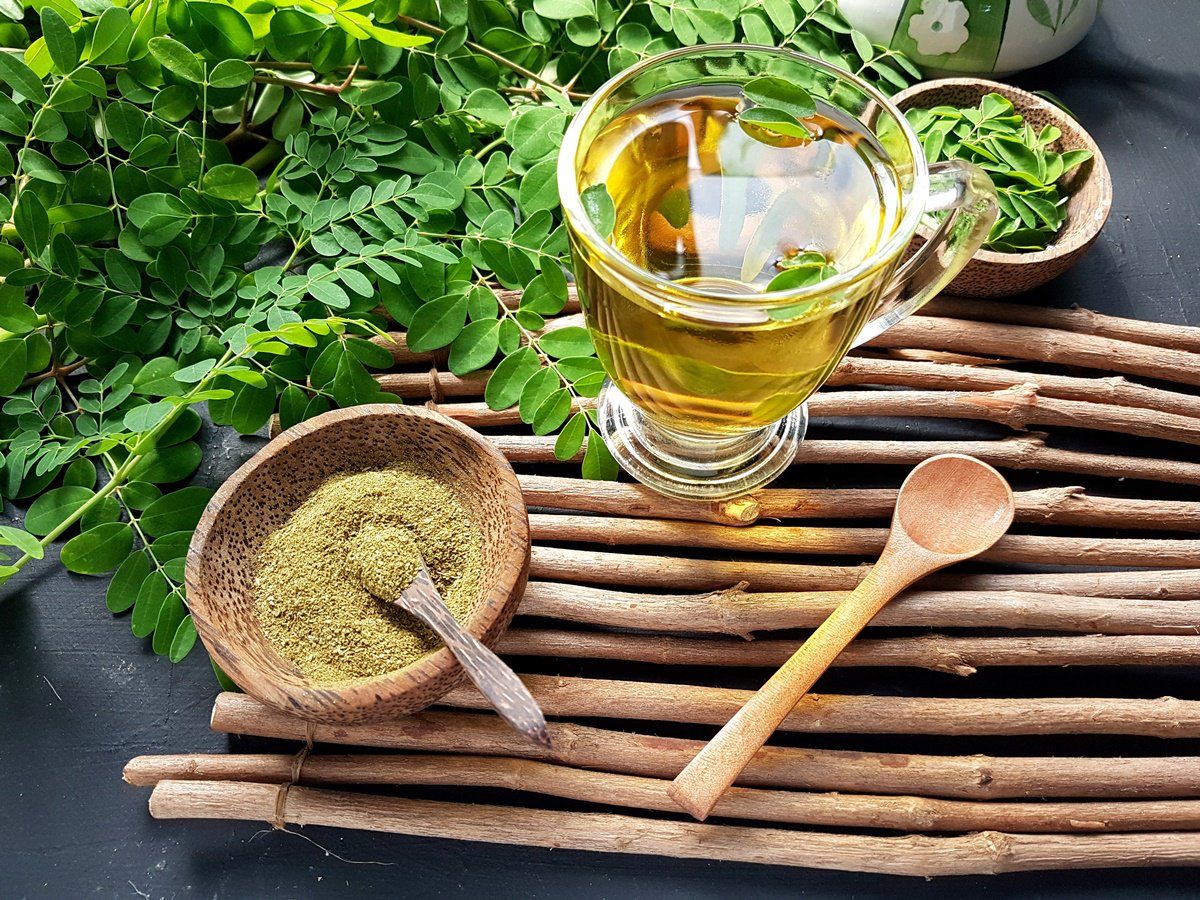
Source: pinimg.com
Moringa, a plant often hailed for its nutritional prowess, also boasts impressive environmental benefits. Its resilience and rapid growth make it a valuable asset in sustainable agriculture, offering a pathway towards food security and ecological harmony. This section delves into the environmental advantages of cultivating moringa, highlighting its drought tolerance and the potential for community-based projects.The remarkable drought-resistance of the moringa tree makes it an ideal crop for arid and semi-arid regions where water scarcity is a pressing issue.
This resilience translates into significant environmental benefits, as moringa can thrive in conditions where other crops struggle. This adaptability allows for agricultural expansion in challenging environments, contributing to increased food production in areas with limited water resources.
Environmental Benefits of Moringa Cultivation
Moringa’s rapid growth cycle contributes to faster land regeneration and soil improvement. Its deep root system helps prevent soil erosion and enhances water infiltration. This process contributes to the overall health and fertility of the land, promoting a more sustainable agricultural system. Furthermore, the leaves and other parts of the moringa plant are readily utilized, minimizing waste and maximizing resource efficiency.
Drought-Resistant Nature of Moringa
Moringa trees are exceptionally drought-tolerant, possessing a unique ability to survive and even thrive in conditions of prolonged water scarcity. This resilience stems from their deep root systems that tap into groundwater reserves, allowing them to extract moisture from the soil effectively. This adaptability makes moringa a valuable asset for agricultural communities in arid and semi-arid regions, where water is a precious and often limited resource.
Its ability to withstand periods of drought contributes to food security in these regions, making it a crucial part of sustainable agricultural practices.
Sustainability of Moringa Cultivation
Moringa cultivation practices can be adapted to enhance sustainability. Using organic farming methods, avoiding excessive use of chemical fertilizers and pesticides, and promoting crop rotation can help maintain soil health and reduce environmental impact. The efficient use of water resources through drip irrigation or rainwater harvesting techniques further enhances the sustainability of moringa cultivation.
Community Projects Using Moringa for Food Security
Numerous community projects leverage moringa to address food security issues. These initiatives often involve training local farmers in sustainable moringa cultivation techniques, enabling them to produce a nutritious and readily available food source. Such projects foster self-sufficiency and empower communities to become more resilient to food insecurity. The establishment of moringa farms and processing facilities can also create employment opportunities, further contributing to economic development and overall community well-being.
Sustainable Practices in Moringa Cultivation
- Organic Farming Practices: Utilizing natural pest control methods, composting, and crop rotation can enhance soil health and reduce reliance on chemical inputs, promoting long-term sustainability.
- Water Conservation Techniques: Implementing drip irrigation, rainwater harvesting, and efficient water management strategies can significantly reduce water consumption and optimize water use for moringa cultivation, particularly in water-scarce regions.
- Integrated Pest Management (IPM): Implementing IPM strategies minimizes the need for chemical pesticides, protecting beneficial insects and preserving biodiversity in the agricultural ecosystem.
- Crop Rotation: Rotating moringa with other crops can enhance soil fertility and reduce the risk of soil depletion, leading to a more sustainable agricultural system.
- Nutrient Management: Using organic fertilizers and compost improves soil health and provides essential nutrients for moringa growth, reducing the need for synthetic fertilizers.
Concluding Remarks
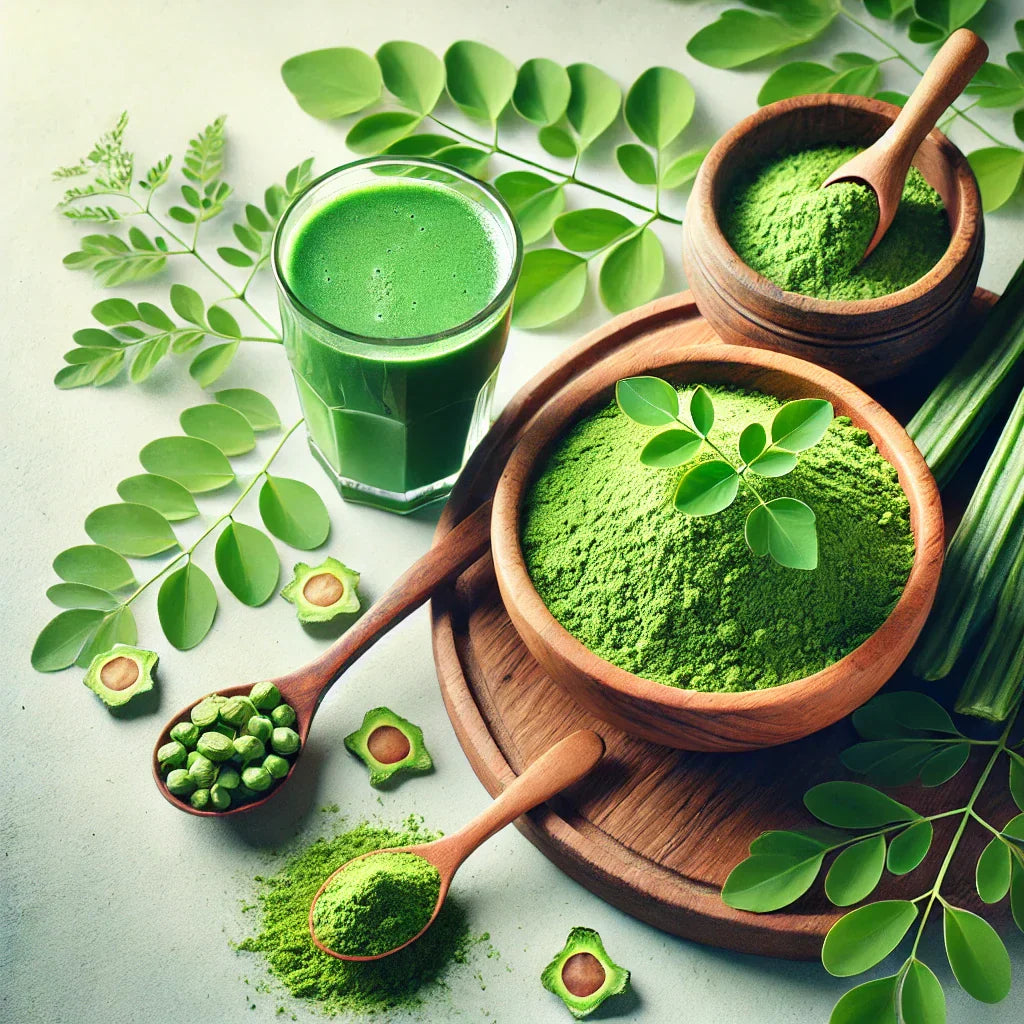
Source: com.au
In conclusion, Moringa leaves emerge as a compelling addition to a healthy lifestyle. Their impressive nutritional content, diverse applications, and potential health benefits make them a valuable asset. While acknowledging the importance of consulting with healthcare professionals, incorporate Moringa into your diet thoughtfully and responsibly. The key is a balanced approach, understanding the potential benefits, and incorporating this superfood in a way that complements your overall health plan.
Embrace the power of Moringa for a healthier and more vibrant you!
FAQ
What are the common side effects of consuming Moringa?
While generally safe, some individuals may experience mild digestive discomfort, such as bloating or gas, especially when starting with high doses. Consult your doctor if you have concerns.
How much Moringa should I consume daily?
Recommended dosages vary based on age, health condition, and individual needs. It’s best to consult a healthcare professional to determine the appropriate amount for you.
Can Moringa interact with other medications?
Yes, Moringa may interact with certain medications, including blood thinners. Always inform your doctor about any supplements you’re taking, including Moringa, before adding it to your regimen.
Is Moringa suitable for pregnant or breastfeeding women?
While Moringa is generally considered safe, it’s essential to consult a healthcare professional before incorporating it into your diet if you’re pregnant or breastfeeding.


